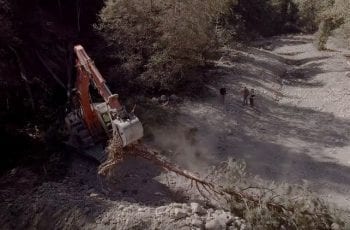
CalTrout’s Shasta team has completed an instream habitat restoration project that will help recover threatened coho salmon in the Scott River, the most productive coho stream in California. The Scott River is an important tributary to the Klamath River, one of the largest rivers in California.
A stretch of the South Fork Scott River had become severely degraded from mining and agriculture, leading to incised channels, disconnection from the natural floodplain, and a lack of instream habitat complexity. This stream reach was identified as critically important spawning and rearing habitat for Southern Oregon/Northern California Coast Coho (SONCC) salmon (a federally-listed threatened fish) in the 2014 Recovery Plan by NOAA Fisheries. These degraded conditions cause stress for the Scott River coho salmon population. Coho salmon require complex habitat, wetlands, and deep pools for juveniles to rear in and for adults to rest in while migrating upstream.
Restoration activities kicked off with excavating an inset floodplain to reconnect the river to off-stream rearing habitat for juvenile salmon. Additionally, intact floodplains provide recharge to groundwater basins, supporting cooler base flows in the summer, and also reduce runoff, resulting in an overall increase in stream flow during the dry season, when it is needed. Coho salmon are particularly adapted to the physical habitat elements that are generated from healthy channel and floodplain interactions. Restoration also involved felling trees and installing woody debris in the stream. Woody debris creates sanctuary spaces for juvenile coho. Our team planted native vegetation, including trees such as willows, alders, and cottonwoods, to restore the natural riparian ecosystem.
This project followed another from 2014 in which we assisted the California Department of Fish and Wildlife and partners in relocating more than 30,000 juvenile coho salmon into the South Fork Scott River. These fish become stranded upstream during extreme drought conditions.
CalTrout’s Marketing team (Tracey and Alisan) recently toured the property with our Shasta Program Director Drew Braugh, Preston from Siskiyou Resource Conservation District, and researchers from UC Davis. We got to see first-hand the incredible transformation of this stream reach.
Watch short clip of restoration activities.
This successful project was an important opportunity to build strong, strategic partnerships between landowners, agencies, and conservation organizations. Thank you to our partners, Siskiyou Resource Conservation District, Scott River Water Trust, California Department of Fish and Wildlife, US Fish and Wildlife Service, and Timbervest, LLC.
Special thanks to our generous funders: California State Coastal Conservancy and California Department of Fish and Wildlife.
Click here for more information on CalTrout’s salmon recovery projects from our Shasta office.







